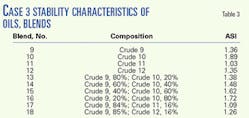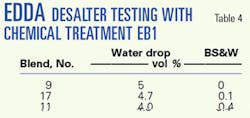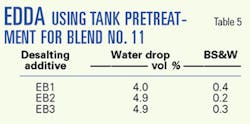Combining a proprietary asphaltene stability index (ASI) and a laboratory simulation of the desalting process can predict desalter problems in a refinery when incompatible crude blends are suspected.
These tests can determine corrective action that includes blending strategies to avoid asphaltene instability and chemical treatment programs that enable the refinery to run difficult blends.
Refineries are processing more opportunity crude oils due to fluctuating oil prices and the squeeze on profit margins. In some cases, the crude unit is required to run crude oils for which the operators have no experience so that potential problems are unknown.
Often, stable crude oils can form unstable mixtures when blended together. Specifically, when a paraffinic crude is blended with an asphaltenic crude, asphaltenes can destabilize and precipitate for some blend ratios. Even small amounts of precipitation can lead to fouling, foaming, and desalter upsets.
Desalting
One of the first steps in refining crude oil is desalting, which thoroughly mixes wash water with the oil to facilitate removal of excess salts, metals, and solids. Asphaltenes can stabilize water-oil emulsions leading to increased desalting problems.1 2
Asphaltenes can cause desalter operating upsets via increased solids in the effluent water, increased current draw, and an increased rag layer. Poor desalting due to asphaltene stabilized emulsions leads to increased salts carried to other areas of the refinery.
Salt carryover leads to increased tower overhead corrosion, exchanger fouling, shorter coker furnace run lengths, and catalyst poisoning.
Asphaltenes are generally considered the highest molecular weight component of a crude oil. They contain condensed aromatics and heteroatoms like sulfur, nitrogen, oxygen, nickel, and vanadium. In crude oils, asphaltenes exist as a colloidal suspension made of micelles of an asphaltene core surrounded by resins.3 4
Asphaltenes are dark brown to black solids when separated from the oil by adding a nonpolar solvent. Asphaltenes are defined as a solubility class-the portion of an oil or bitumen that is insoluble in heptane but soluble in benzene or toluene.5-7
In an asphaltene-stabilized emulsion, the asphaltenes might exist as a rigid, cross-linked network absorbed from the oil into the oil-water interface.8 The emulsion's high stability may be due to strong interfacial films formed by asphaltene networks.9 10
It has also been reported that asphaltenes, at their solubility limit in oil, tend to readily form strong interfacial films, giving the most stable emulsions.8 Efforts to predict asphaltene stability in crude oil may help correlate the ease of demulsification in desalter operations.
Many methods exist to predict crude oil stability. The ASI test predicts the stability of asphaltenes in crude oil and crude blends. In this study, a combination of the ASI test and a laboratory simulation of the desalting process (EDDA test) was used to predict field performance and develop strategies to mitigate desalter upsets due to asphaltene destabilization.
Experimental methods
The ASI test measures asphaltene stability in crude oil by determining the onset of asphaltene flocculation using a solvent titration method. The onset measurement is done in an asphaltene precipitation detection unit (APDU), which has a solids detection system that uses a near infrared (NIR) laser to determine the onset of asphaltene flocculation.
The oil sample is heated and allowed to equilibrate. A nonsolvent is then titrated into the solution, and the NIR laser transmittance is monitored. Laser transmittance increases in the initial stages of titration due to a decrease in optical density resulting from solvent addition. When asphaltenes begin to flocculate, laser transmittance will decrease, resulting in an inflection in a plot of transmittance vs. volume of added nonsolvent.
The point of inflection, expressed as ASI, corresponds to the point of asphaltene precipitation and provides a relative measure of how stable the asphaltenes are in the oil. Unstable oil usually has an ASI of between 0 and 1.5. Stable oil generally has an ASI of 2.5 or higher. Between 1.5 and 2.5 the oil is considered moderately unstable.
The desalting process was simulated in the lab using a bench-scale EDDA procedure.
Results
Tables 1-3 show stability data for three refineries with desalter upsets. All the oils and blends tested have an ASI in the unstable-to-moderately stable range. This means these oils have a high-to-moderate probability of asphaltene destabilization during processing.
Blending crudes leads to one of two things. One, the oils are compatible and the blend has an ASI between the most stable and least stable crude. In this case, while the blend is generally less stable than the more stable oils, blending the oils together does not lead to immediate asphaltene destabilization.
Alternatively, the crude oils are not compatible, which occurs when the blended oil has an ASI less than the least stable oil in the blend. In this case, blending the oils together will lead to immediate asphaltene destabilization. These conclusions have been proven in practice. Also, analytical testing confirmed asphaltene instability to be the root cause.
Case 1
In the example in Table 1, the refiner introduced a new crude into the normal feed (Crude 2). When this crude was introduced into the feed, problems in the desalter occurred. A rag layer built up, which shorted out the bottom grids.
All of the crudes were compatible with each other; simply blending any combination of the crudes did not lead to immediate asphaltene precipitation.
Crude 2 was the least stable of those tested and was considered unstable with regard to potential asphaltene instability. The blend that caused desalter upsets was Feed 4. This blend had an ASI in the unstable range; therefore, the problems were probably caused by asphaltene destabilization.
Crude 2 gave a high economic incentive even though the refiner understood that many of the crude blends would lead to asphaltene instability. The refiner took several steps to minimize the impact of asphaltene instability.
A treatment program containing asphaltene stabilizers was injected into Crude 2 as it was transferred into storage tanks. Increasing the wash water rate from 4.0 to 5.3% improved desalter performance.
This increases the droplet population-bringing the droplets closer together-and also increases the oil-water interfacial area, effectively diluting the surface asphaltene concentration.
A wetting agent was added to control solids, which tend to coprecipitate with asphaltenes and cause oil undercarry. There have been no incidents of oil undercarry using this treatment scheme, even though the crude unit runs heavy crude slates.
Case 2
A refinery was introducing a new crude into its normal diet (Table 2). Introducing Crude 6 resulted in excessive oil undercarry from the desalter. Asphaltene stability testing indicated that feed stability decreased as the amount of Crude 6 in the feed increased.
All of the blends tested had an unstable ASI. In this case, the refinery avoided upset conditions by working with crude purchasing to limit the amount of Crude 6 processed. Blends of higher asphaltene stability were used instead.
Case 3
Refinery 3 noticed an unusual rag layer in the desalter. It also experienced level control problems in the preflash vessel caused by foaming in the preflash vessel. The refinery had recently started running a crude (Crude 9) that had not been processed before, so incompatible crude blending was suspected.
To investigate compatibility issues, the refiner ran asphaltene stability tests on individual crudes and blends. The crudes processed when the desalter upset began contained a 50-50 blend of Crudes 9 and 10.
Blending these two crude oils did not result in immediate asphaltene destabilization, proven by the fact that all the blends had an ASI value between the most stable oil, Crude 10, and least stable oil, Crude 9.
Blends 13 and 14 are both unstable. Blends 15 and 16 are both moderately unstable. Switching to a blend containing 40% or less of Crude 9 resulted in a feed that could be processed without desalter upsets.
The refinery also wished to run Blends 17 and 18 (Table 3). Testing, however, indicated possible problems with these blends.
ASI testing indicated that the individual oils were unstable, namely Crudes 11 and 12. Asphaltene stability testing of Blend 17 showed it to be unstable as well.
Emulsion stability
Some of the crudes and blends were also evaluated for emulsion stability using the EDDA desalter simulation test. For this test we used 5% wash water, equivalent to that used in the refinery. Table 4 shows test results. "Water drop" gives an indication of how rapidly the emulsion would be resolved in the desalter.
Blend 9 had no problems. Blend 17 might cause some problems in the desalter and Blend 11 was expected to pose a problem. Dehydration (bottoms sediment and water) would also be a problem for Blend 11. This was indeed the experience on the desalter.
Chemical treatment
We evaluated several chemical treatment schemes. The best treatment involved injecting an additive that contained asphaltene stabilizers into the crude oil as it was transferred into tankage.
Desalter performance could be further enhanced if the old chemical treatment, EB1 (Table 4), was replaced by either EB2 or EB3. Table 5 summarizes these data.
Preflash foaming
The other problem was preflash foaming. Small solid particles can stabilize foam. Asphaltene precipitation to form small asphaltene particles at the air-hydrocarbon interface can cause stable foam in the preflash vessel.
A defoamer was injected into the preflash feed, which eliminated the foam problem. The refinery changed its feed to use less of the unstable oil and to process more stable blends, so incompatibility issues have subsided.
The refinery is planning to treat the incoming crude shipments with the asphaltene stabilizing additive. When the refinery begins running the problem Crude 9 again, it will be better prepared to handle potential incompatibility problems. F
References
The authors
Joseph L. Stark is the Fouling Control Group Manager in the Industrial Division of Baker Petrolite, Sugar Land, Tex. His focus at Baker Petrolite is to develop and direct new and novel technologies to improve the stability of petroleum fluids. Before joining Baker Petrolite in 1998, he worked in the catalyst division of Shell Chemical Co. as a postdoctoral research chemist. Dr. Stark received a BA in chemistry from Ohio State University and a PhD in inorganic chemistry from Kansas State University.
Joe Nguyen is a research associate at Baker Petrolite, Sugar Land, Tex., responsible for product development and troubleshooting refinery process problems. During his 17 years at Baker Petrolite, he has also worked in the areas of antifoulants and fuel additives. Nguyen graduated from the University of Texas with degrees in chemistry and mathematics.
Lawrence N. Kremer is Senior Technical Consultant at Baker Petrolite, Sugar Land, Tex., responsible for product development and support for demulsifiers and desalting aids, metals passivation additives, cleaners, defoamers, and alkylation aids. In his 19 years at Baker Petrolite, he has also worked in the areas of antifoulants, corrosion inhibitors, fuel additives, petrochemical additives, and water treatment products. Dr. Kremer has a BS in chemistry from the University of Texas and a PhD in physical chemistry from the University of Utah.










